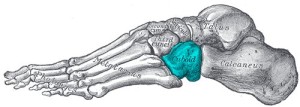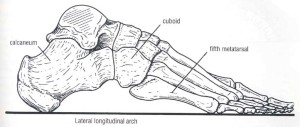 Within the amazing structure that is our foot we find the cuboid bone. The cuboid bone, located on the outer edge of the foot, has six sides (hence its name) with each surface playing an important role. The cuboid helps stabilize the foot and the movement of the toes, as well as facilitating good weight distribution.
Within the amazing structure that is our foot we find the cuboid bone. The cuboid bone, located on the outer edge of the foot, has six sides (hence its name) with each surface playing an important role. The cuboid helps stabilize the foot and the movement of the toes, as well as facilitating good weight distribution.
Each foot has three arches—inner, outer and transverse. The cuboid is involved to some degree with all three.
An arch is a curved structure that most often bears and transfers weight. Weight falls onto the arch compressing the arch but also moving energy out to either side. Every arch has a keystone which is usually at its apex. The keystone takes the form of a wedge and locks all of the building materials or in this case bones, into position.
The cuboid bone is the keystone of the lateral arch of the foot which is comprised of the calcaneus, the cuboid, and the fourth and fifth metatarsals.
The cuboid also plays a role in the inner arch as the tibialis posterior, which is the main muscle involved in the hoisting for the inner arch, is the only muscle that attaches to the cuboid bone.
Additionally, the cuboid is part of the transverse arch while not its keystone. The transverse arch is lifted by the engagement of the fibularis muscle (formerly peroneal) that runs down the outer calf. At the ankle the fibularis tendon changes direction, moving forward and slightly down passing over the side and then under the cuboid bone before moving toward towards the inner foot.
I’ve written before about pulley systems in the body and here is another one with the cuboid bone acting as a pulley for the fibularis which acts as the rope. As fibularis longus contracts it is pulled out and up, rolling the cuboid in and down.
Each foot has twenty-six bones with thirty-three possible articulations for movement. If the keystones of the three arches are well situated they combine to create a ridiculously strong and stable foot. The trouble of course with having twenty-six bones in the foot there are twenty-six opportunity’s for misalignment.
If any of these bones are out of place, but especially the keystones it become more and more difficult to function correctly. And for these bones to be in place as designed we need to learn to walk and stand correctly.
***

